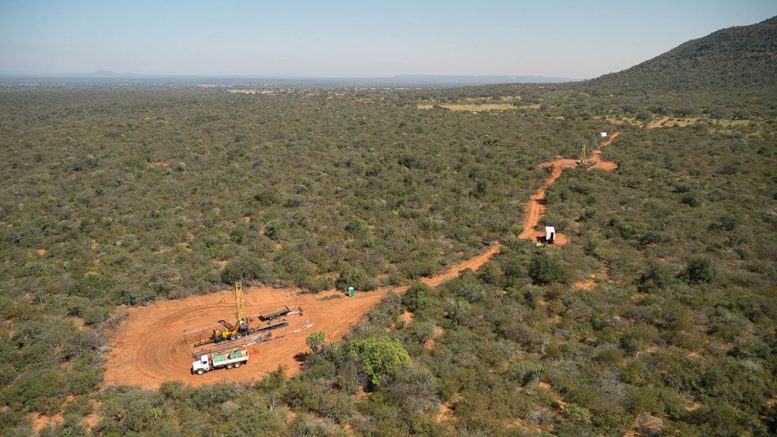Platinum Group Metals (TSX: PTM) tabled its definitive feasibility study (DFS) for the Waterberg platinum group metals (PGM) project in South Africa’s Bushveld Complex outlining a boost in palladium, platinum, gold and rhodium (4E) reserves, as well as enhanced economics using recent spot metal prices.
The DFS envisions annual production of 420,000 combined oz. 4E over a 45-year mine life, plus nickel and copper by-products.
Waterberg is a joint venture between Platinum Group Metals (37.05%), South Africa-based major Impala Platinum Holdings (Implats) (15%), Japan Oil, Gas and Metals National Corp. (JOGMEC) (12.95%), Japanese trading company Hanwa (9.75%) and Black Economic Empowerment (BEE) partner Mnombo Wethu Consultants (26%). Factoring in Platinum Group’s 49.9% ownership in BEE Mnombo, it has an effective 50.02% interest in the Waterberg joint venture.
The DFS — incorporating Sept. 4 buoyant 4E spot prices — shows a substantial mineral reserve boost over the 2016 prefeasibility study results. Proven and probable reserves in all six zones of the deposit are estimated at 187.5 million tonnes grading 0.94 gram platinum per tonne, 2.04 grams palladium per tonne, 0.05 gram rhodium per tonne and 0.21 gram gold per tonne, or a combined 3.24 grams 4E per tonne using a 2.5 gram 4E per tonne cut-off grade. The 19.5 million contained oz. 4E metal reserves in this latest tally is a 58% increase from the 2016 study’s 12.32 million contained oz. 4E metal in reserves.
Total measured and indicated resources — inclusive of reserves — in the Waterberg DFS are pegged at 242.4 million tonnes at 0.98 gram platinum, 2.13 grams palladium, 0.05 gram rhodium and 0.22 gram gold, or a combined 3.38 grams 4E using the same 2.5 gram 4E cut-off grade.
Under the recent metal spot price valuation model, the DFS indicates a US$982-million, after-tax net present value (NPV) at an 8% discount rate. However, with a three-year, trailing average metal-price model, the NPV drops to US$333 million. After-tax internal rates of return are 20.7% at spot prices and 13.3% using three-year trailing metal prices.
Platinum Group Metals’ CEO, Michael Jones, said in a press release that the DFS “provides a clear outline of the world-class nature of the Waterberg palladium deposit, and concludes that it can be one of the largest fully mechanized, low-cost PGM mines in the world.”
But big mines don’t come cheap. Capital costs to build Waterberg are estimated at US$874 million, including US$87 million in contingencies, with almost half of the projected spend allocated for underground development. Life-of-mine average site cash costs (inclusive of by-product credits and smelter discounts) are projected at US$640 per oz. 4E under the spot metal price valuation scenario, placing the project in the lower quartile of the PGM industry cost curve, according to Platinum Group’s data and projections.
A formal construction decision by the joint-venture partners comes after mining rights are granted, which is expected in early 2020, and first production is estimated 3.5 years later in late 2023, with ramp-up to a steady state by 2027. The development plan uses twin decline tunnels to access the shallow orebody a couple hundred metres below surface, and extends to 1,280 metres’ depth.

A geotechnician checks core sampling at Platinum Group Metals’ Waterberg project on the North Limb of South Africa’s prolific Bushveld Complex. Credit: Platinum Group Metals.
The Waterberg mine plan aims to exploit six zones over an 8 km strike length of the orebody that sits in the North Limb of the Bushveld Complex. However, unlike many other orebodies, or reefs, in the region that have relatively narrow widths (typically less than 1 metre to a couple metres), Waterberg’s ore horizons have true widths ranging from 2 metres to 107 metres that allow for more efficient bulk-mechanized mining. Additionally, metallurgy differs from other regional PGM operations in that Waterberg is more palladium-dominant, with strong gold credits — a definite valuation boost under recent metal pricing.
Platinum Group’s joint-venture partner Implats, one of the world’s largest PGM producers, bought into the Waterberg project in 2017 under a US$30-million strategic investment for a 15% ownership (8.6% acquired from Platinum Group and 6.4% from JOGMEC). Additionally, Implats holds a right of first refusal for concentrate offtake.
Under the 2017 transaction terms, completion of the DFS now triggers Implats formal review and option to boost its stake to 50.01% through additional purchases and earn-in arrangements from the joint-venture partners totalling US$166 million. BEE partner Mnombo would keep a 26% interest.
If the project comes to fruition it would provide economic and social benefits into the region, with an estimated 1,170 employees involved in long-term operations.
Capitalizing on the recent strength in the palladium market to bolster its treasury, Platinum Group completed a financing package that saw a US$10.4-million, bought-deal financing at US$1.25 per share through BMO Capital Markets. Additionally, the company completed two private-placement financings of US$10 million and US$9.2 million to Liberty Metals & Mining Holdings (now an 18.9% shareholder), and to Hosken Consolidated Investments subsidiary Deepkloof (now a 30.2% shareholder).
In conjunction with some of the financing proceeds, Platinum Group also drew US$20 million from its new credit agreement with Sprott Private Resource Lending to repay in full a secured US$43-million debt facility it had in place with Liberty Metals, significantly reducing and deferring the company’s overall debt position.
Platinum Group recently teamed up with Anglo American Platinum to form Lion Battery Technologies, a venture aiming to fast-track development of potential next-generation battery technology using platinum and palladium.
Although still an early-stage technology, the venture will form university partnerships to advance studies and potential battery development that could lead to new applications and markets for PGMs.
After releasing its DFS on Sept. 24, shares of Platinum Group Metals slipped 5% to $2.36. At press time shares slipped further to $2 apiece, giving the company a $117-million market capitalization. The company’s 52-week trading range is $2.92 to $1.36.






Be the first to comment on "Waterberg study pegs 45-year mine life for Platinum Group Metals"